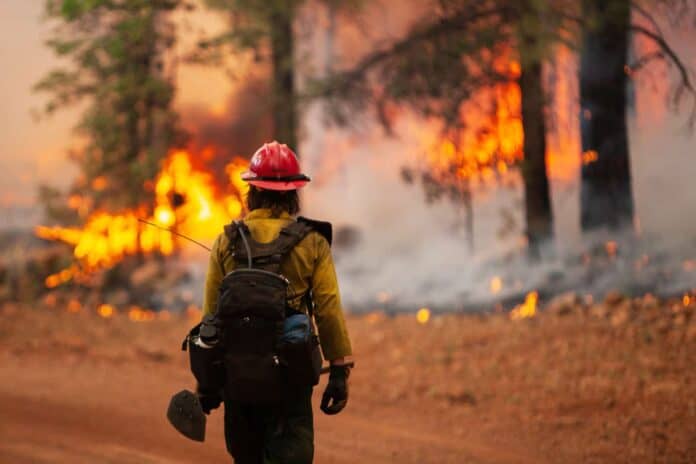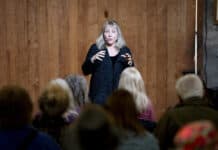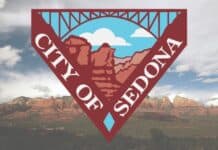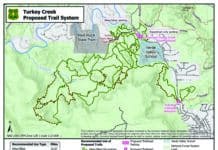
The Arizona Department of Environmental Quality, U.S Forest Service and Arizona Department of Forestry and Fire Management held a public meeting about prescribed fire management on Wednesday, Oct. 2, at the Camp Verde Community Library.
The fall prescribed burn season for the Coconino National Forest typically runs from the first week of October through December.
“Fire managers across [the] three districts have plans for 14 prescribed burn projects spanning locations across the national forest, comprising thousands of acres,” the Coconino National Forest wrote in a Sept. 24 press release. “Since prescribed burns are dependent upon weather conditions, some or all these projects may be implemented.”
During the meeting, residents complained about the amount of smoke produced by prescribed burns in October and November 2023.
“We had, again, three monitors out there, and none of them exceeded the midnight-to-midnight standard,” ADEQ Smoke Management Meteorologist Brody Droppleman said. The Environmental Protection Agency’s smoke standard involves measuring particles 2.5 micrometers or smaller, known as PM2.5, over a 24-hour period from midnight-to-midnight. These results, Droppleman said, should not exceed 35.5 micrograms per cubic meter.
“It’s more the perception of the smoke,” Droppleman said. “If you’re smelling smoke, you are breathing smoke. If you are sensitive, you should limit your activity. But based on the EPA standards that are set, we did not see any value over that 35.5 from midnight to midnight, and that’s what we have to use to regulate because that is set by the EPA itself.”
While ADEQ’s monitoring data shows that Sedona’s air quality monitors registered above-standard levels of PM2.5 for a total of 11 hours on Oct. 20, and 22 hours on Nov. 28 and 29, during last year’s prescribed burns, Camp Verde’s monitors stayed within the EPA’s preset limit.
If a monitor exceeds the 35.5 standard, no additional ignitions can occur and the EPA health advisory level is increased.
The USFS was given $1.4 billion in 2023 with the passage of the Bipartisan Infrastructure Law to conduct burns on over 50 million acres of public lands to reduce the risk of future fires affecting populated areas. Locally, the Forest Service’s planned burn projects include what it calls the Four Forest Restoration Initiative, which will burn nearly 200,000 acres of the Kaibab, Coconino, Apache-Sitgreaves and Tonto National Forests at a cost of $111.1 million. The San Carlos Apache Tribe has also received $32 million to burn 2,417 acres, along with 10 other locations in the West.
The materials presented at the meeting stated that prescribed burns “[help] reduce the risk of wildfires to communities, [protect] infrastructure like high-power utility lines and watersheds, [improve] the health of Arizona’s forests by reducing dead/dying vegetation and diseased trees [and] enriches soil nutrients.”
“The reality of it is that in these adapted ecosystems where they need fire,” USFS Southwest Regional Smoke Coordinator Ron Sherron said. “Not only just fire, they need smoke … Smoke is what releases some of that to allow those forests to regenerate, not just the fire, not just the heat from the fire, but smoke.”
A July study from Oregon State University suggested that smoke from wildfires can be beneficial to tree seedlings by reducing the amount of sunlight reaching the lower canopy, thereby reducing an area’s surface temperature.
“That extra cooling effect may be important during extreme heat events when canopy cover and topography do not provide enough protection from harmful and potentially lethal temperatures in the understory,” study coauthor Amanda Brackett said in a press release.
ADEQ Smoke Management Meteorologist Matt Pace argued that fire management has become more challenging as annual precipitation has decreased, dropping from an average of 14.11 inches to an average of 11.43 inches over the past 30 years. Locally, the Verde Valley has been experiencing higher-than-average precipitation over the last two years.
“It’s also getting windier, believe it or not,” Pace said, adding that the Arizona Average Wind five-year rolling average has increased from 23.6 miles per hour in 2001 to 26.2 miles per hour in 2023. “Now there’s not a lot of wind data. It only goes back to about 1995, but using about, I think it’s 18 stations around the state, we see that we are seeing an increase in wind speeds. This is often attributed to if you have dry storm systems move through, which there’s been a lot recently … You get stronger winds because you just have a stronger system. You have more winds, you don’t have any rain. So this kind of lines up with the precipitation that we see. So it is getting drier, it’s getting warmer and it’s getting winder.”
“We’re at Preparedness Level 5 nationally, which means that resources are as thin as they usually get,” the Red Rock Ranger District’s District Ranger Alex Schlueter later said. “There’s so many wildfires around the nation, in addition to the hurricanes, both the one that happened last week and the current one, that we may not have enough resources to pull off our prescribed burning.”
A smoke complaint hotline is now available at (928) 226-4608.
To watch the recording of the meeting, visit azdeq.gov/smokemanagement.
The EPA and USFS jointly manage the AirNow fire and smoke map at fire.airnow.gov.





















